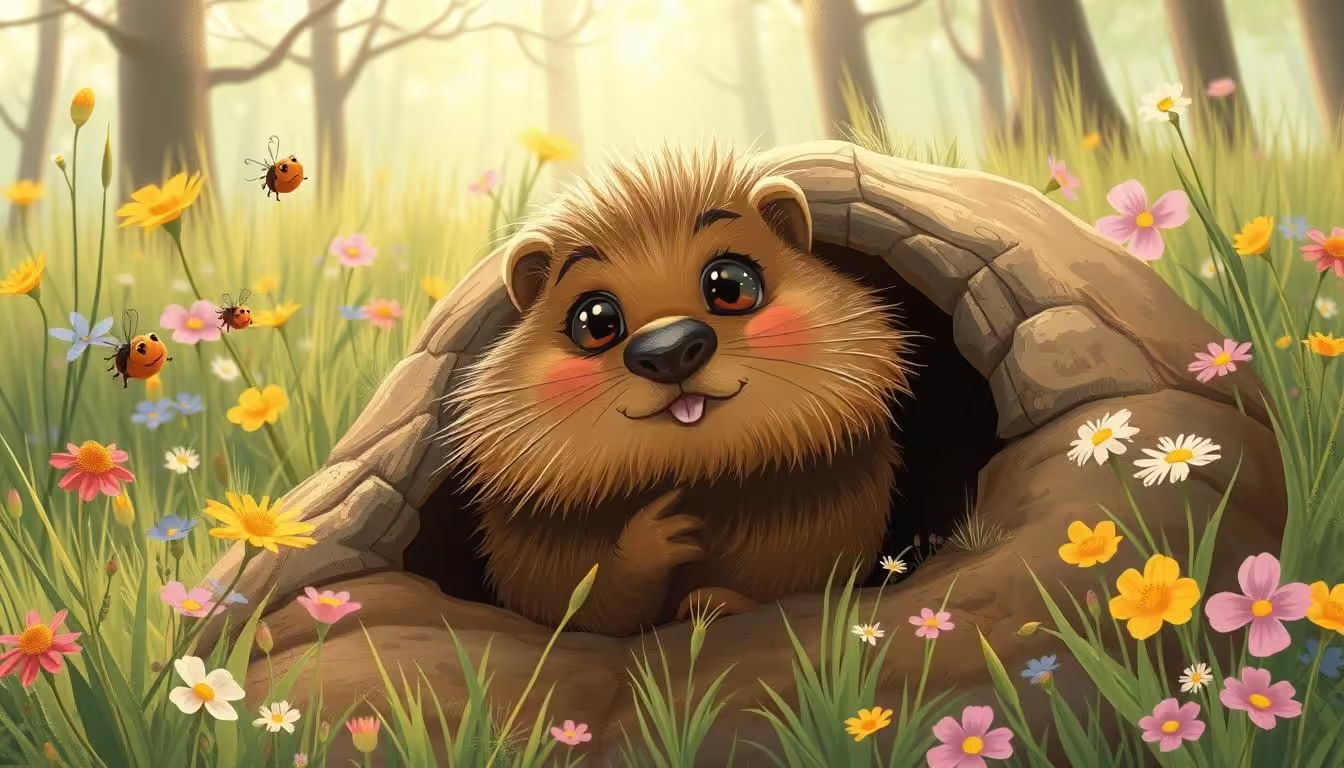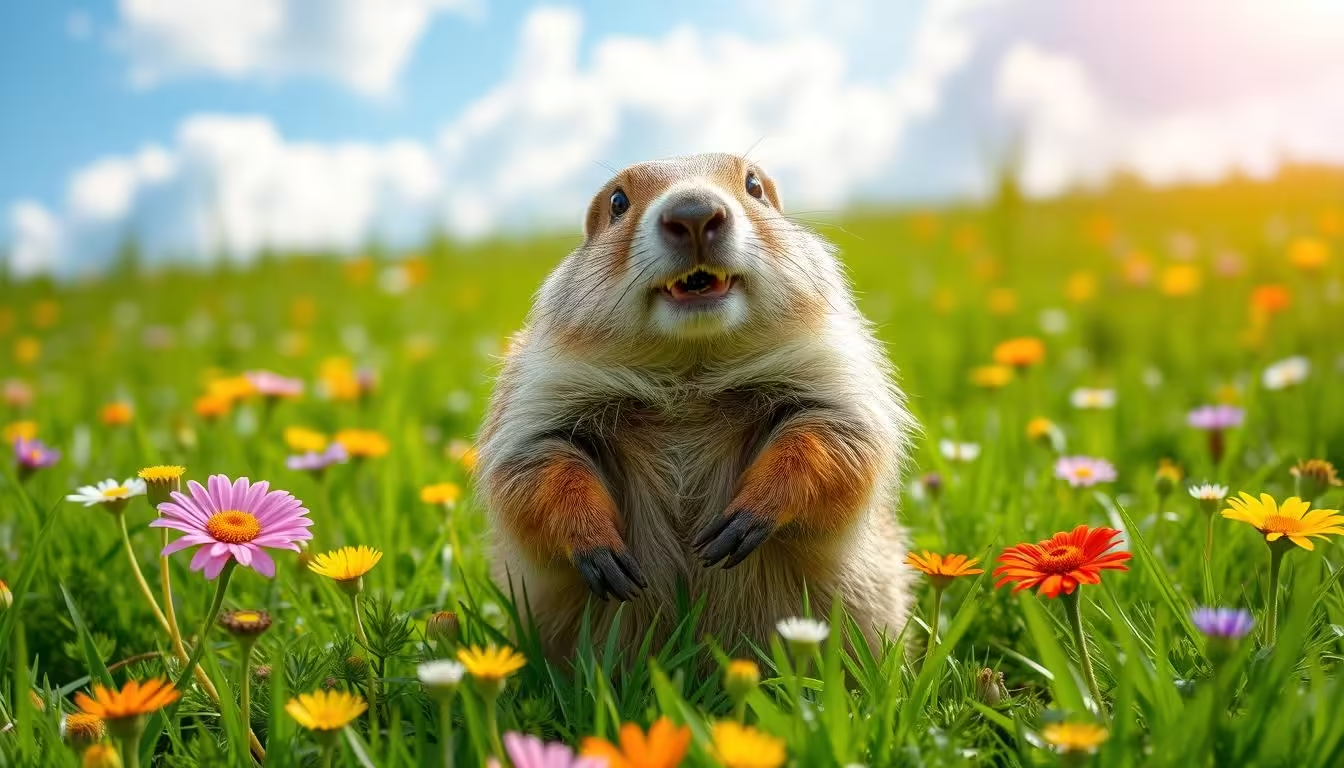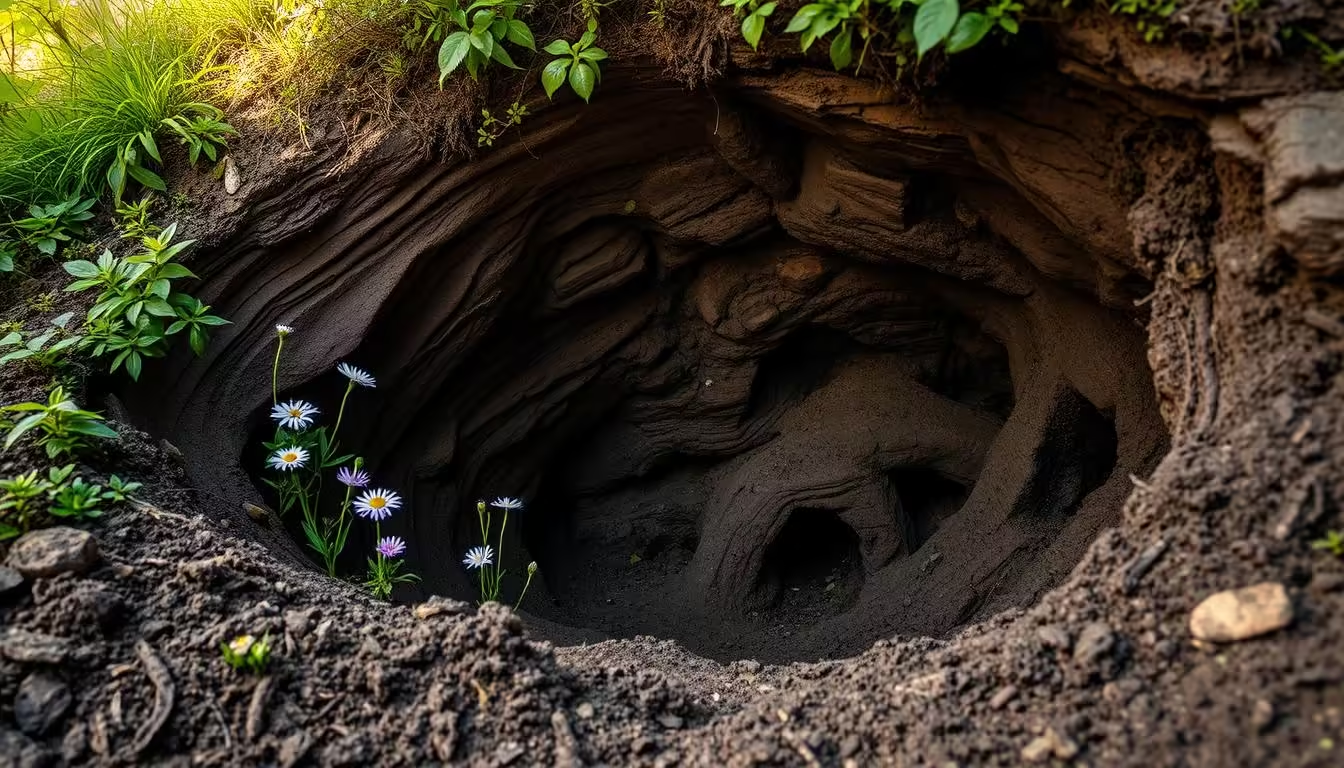Groundhogs, also known as woodchucks or whistlepigs, are big rodents in the squirrel family. They live in North America, from Canada to the southern United States. These herbivores are famous for digging burrows, hibernating, and being part of Groundhog Day.
They usually weigh about 13 pounds and can be up to 24 inches long. They also have a 7-9 inch tail.
Key Takeaways
- Groundhogs are large rodents that can weigh up to 13 pounds and measure up to 24 inches in length.
- They are renowned for their impressive burrowing skills, creating complex underground tunnel systems.
- Groundhogs are known for their unique hibernation habits, where they enter a state of deep sleep and lower their body temperature and heart rate.
- These creatures play a significant role in the popular Groundhog Day tradition, where their behavior is believed to predict the duration of winter.
- Groundhogs are predominantly herbivorous, feeding on a variety of vegetation, including grasses, greens, and legumes.
Overview of Groundhogs: An Introduction to These Unique Creatures
Groundhogs, also known as woodchucks, are the largest members of the squirrel family. They have a distinctive look and interesting behaviors. They look like bears when standing on their hind legs, with short ears and a short tail. Their teeth keep growing, which is useful for eating and digging.
What Are Groundhogs?
Groundhogs (Marmota monax) live in North America, from Alaska to Alabama. They have a thick grey undercoat and longer guard hairs that make them look frosted. They also have sharp claws for digging and are good at swimming and climbing trees.
Physical Characteristics of Groundhogs
Adult groundhogs are 40 to 65 centimeters long and weigh 2 to 4 kilograms. They can grow bigger in places with no predators and lots of food. They have strong jaws and teeth that grow all their lives. This helps them dig and eat grasses, plants, and insects.
| Characteristic | Measurement |
|---|---|
| Length | 40 – 65 cm (16 – 26 inches) |
| Weight | 2 – 4 kg (4 – 9 lbs) |
| Maximum Length | 80 cm (31.5 inches) |
| Maximum Weight | 14 kg (31 lbs) |
Groundhogs have special traits that help them live underground and in different places across North America.
The Habitat of Groundhogs: Where They Live
Groundhogs, also known as woodchucks, are fascinating creatures. They thrive in various habitats across North America. They prefer areas where forests meet open fields or meadows. This balance gives them cover and access to food.
Preferred Environments
Groundhogs live in different places, from valley bottoms to alpine tundra. But they avoid dense forests. Their best home is a mix of grasslands, shrublands, and wooded areas. This mix gives them everything they need for their activities all year.
Groundhog Burrows: Structure and Purpose
Groundhogs are great diggers. They make complex burrow systems that can be up to 6 feet deep and 20 feet wide. These burrows have 2 to 12 entrances and different rooms for nesting, food, and a “bathroom”.
Groundhogs use these burrows all year. They rest, seek safety, and raise their young here.
The burrow system is key to the groundhog’s groundhog behavior and interesting groundhog traits. It’s their shelter. It lets them thrive in their favorite places and follow their unique ways.
Diet of Groundhogs: What Do They Eat?
Groundhogs, also known as woodchucks, love to eat plants, fruits, and veggies. They munch on alfalfa, clover, peas, beans, lettuce, broccoli, plantain, and soybeans. When food is hard to find, they also eat tree bark, twigs, and blossoms.
Herbivorous Diet
Groundhogs mostly eat plants, but they also eat insects, grubs, snails, and bird eggs. This mix of foods helps them get all the nutrients they need. It also helps them adjust to changes in food availability.
Seasonal Eating Habits
Groundhogs eat differently depending on the season. In summer and fall, they eat more to gain fat for hibernation. This extra food helps them make it through the cold winter when food is hard to find. They get most of their water from the leaves they eat, needing very little extra water.
| Groundhog Diet Facts | Details |
|---|---|
| Average Weight | 6-12 lbs |
| Dietary Habits | Primarily Herbivorous |
| Favorite Foods | Alfalfa, Clover, Peas, Beans, Lettuce, Broccoli, Plantain, Soybeans |
| Occasional Additions | Insects, Grubs, Snails, Bird Eggs |
| Seasonal Eating Patterns | Increased Consumption in Summer and Fall for Hibernation |
Learning about groundhogs’ eating habits helps us see their important role in nature. Their ability to eat a wide variety of foods makes them successful in their environment.
Groundhog Behavior: Daily Activities and Patterns
Groundhogs, also known as woodchucks, are fascinating creatures with unique behaviors. They are most active in the early morning and early evening. During these times, they come out to find food and enjoy the sun from spring to fall.
Diurnal vs. Nocturnal
Groundhogs are not nocturnal, as many believe. They are actually diurnal, meaning they are active during the day. They spend their daylight hours above ground, doing things like eating, grooming, and sunbathing. Animals like raccoons and opossums, on the other hand, are more active at night.
Social Behavior
Groundhogs have a social structure, even though they seem solitary. They communicate with each other through sounds, including high-pitched whistles. These calls warn other groundhogs of danger, helping them stay safe in their burrows.
Groundhogs usually stay close to their burrows during the day. They rarely go more than 50 to 150 feet away. This helps them protect their territory and find food efficiently.
“Groundhogs are fascinating creatures that exhibit a unique blend of solitary and social behaviors, providing valuable insights into their adaptations and survival strategies.”
Hibernation: The Groundhog’s Winter Sleep
Groundhogs are amazing creatures that hibernate during the cold months. These unique rodents sleep from October to early spring. They show how well they adapt to the seasons.
How They Prepare for Hibernation
When it gets colder and darker, groundhogs start getting ready for sleep. They eat a lot in summer and fall. This builds up fat for their long sleep.
Their body temperature goes from 99°F to as low as 37°F. Their heart rate slows from 80 beats per minute to just 5. They also breathe much less, from 16 times a minute to 2.
Impact of Climate on Hibernation
The length of a groundhog’s hibernation depends on the climate. In warmer places, they wake up sooner. In colder areas, they sleep longer.
This flexibility helps them live well in different places across North America. It’s part of the groundhog facts that make them special.
“Groundhogs are true hibernators, entering a deep sleep that dramatically slows their bodily functions to conserve energy during the winter months.”
Communication: How Groundhogs Interact
Groundhogs are fascinating creatures, and their communication methods are intriguing. They use vocalizations and body language to talk to each other and the world. Understanding groundhog behavior and communication gives us insights into these unique animals.
Vocalizations and Sounds
Groundhogs are known for their high-pitched whistle, which warns others of danger. This sound has made them famous as “whistle-pigs.” They also use barks, chucks, and tooth chattering to send messages and show emotions.
Body Language and Behavior Signals
Groundhogs mainly use body language to communicate. Their tail tells us how they’re feeling – it stands straight up when they’re scared. They also stand on their hind legs to look around and signal to others.
These fascinating groundhog traits and groundhog behavior help them interact with their environment and others. Learning about their communication can give us a deeper understanding of these remarkable animals.
Reproduction and Lifespan of Groundhogs
Groundhogs, also known as woodchucks, are fascinating creatures. They have unique mating rituals and impressive lifespans. These charismatic burrowing mammals emerge from their winter hibernation in early spring. They are ready to engage in the annual cycle of courtship and reproduction.
Mating Rituals
The mating season for groundhogs starts in March or April. This is shortly after they emerge from their burrows. Males are the first to surface, eager to locate and mate with female groundhogs.
The courtship process involves complex vocalizations, as well as intricate body language and behavioral displays. Once a pair has mated, the female groundhog will give birth to a litter of 2-6 young, known as “kits.” This happens after a gestation period of approximately 32 days.
Typical Lifespan in the Wild
In the wild, groundhogs live for about 3-6 years. However, some may live up to 10 years in more protected environments. These resilient creatures have adapted to survive various challenges, from predation to harsh winter conditions.
Their ability to hibernate during the colder months is a crucial survival strategy. It allows them to conserve energy and resources until the spring thaw.
Despite their relatively short lifespans, groundhogs play a vital role in their ecosystems. They aid in soil aeration and serve as a food source for various predators. Their unique behaviors and adaptations continue to captivate, making them a beloved part of the natural world.
Groundhogs and Their Role in Ecosystems
Groundhogs, also known as woodchucks, are vital in their ecosystems. Their burrowing and their place in the food chain show why they’re important. These groundhog facts reveal the interesting groundhog traits that make them key to their environments.
Importance in Soil Aeration
Groundhogs help their ecosystems by aerating the soil. They dig burrows that mix and loosen the soil. This makes the soil better for air and water, helping plants grow and stay healthy.
Their Place in the Food Chain
Groundhogs are a food source for many predators. Coyotes, foxes, bobcats, and birds like hawks and eagles eat them. This keeps the food chain balanced. Groundhogs also affect plants and crops, playing a part in the ecosystem’s balance.
| Groundhog Ecosystem Contributions | Impact |
|---|---|
| Soil Aeration | Improved soil quality and plant growth |
| Food Source for Predators | Maintenance of a balanced food chain |
| Foraging Habits | Influence on local plant populations and agricultural crops |
Learning about groundhog facts and interesting groundhog traits shows their value in ecosystems. It’s important to understand and respect these unique animals and their role in nature.
Groundhog Day: Cultural Significance and Traditions
Groundhog Day is celebrated on February 2nd every year. It comes from ancient Christian traditions and German folklore. German settlers in Pennsylvania brought this custom to the United States. They used groundhogs instead of hedgehogs, which were common in Europe.
The Origin of Groundhog Day
The first Groundhog Day was in 1887 in Punxsutawney, Pennsylvania. It came from older European traditions. These traditions predicted spring’s arrival, like Candlemas and the badger legend.
Celebrations and Events
In Punxsutawney, Punxsutawney Phil, the famous groundhog facts, predicts spring. If he sees his shadow, winter lasts six more weeks. But, Phil’s predictions are only 39% accurate. Staten Island Chuck is much better, with almost 80% accuracy.
Other fun groundhog facts events include the Woollybear Festival in Ohio. It draws over 100,000 people every year since 1972. The Pennsylvania Dutch community also celebrates, adding to the holiday’s cultural richness.
“Groundhogs, also known as woodchucks, belong to the marmot family and can grow up to 25 inches long. They can live for up to 10 years in captivity.”
Groundhog Day is popular, but the Amish don’t celebrate it. They see it as not religious. The Amish, a big part of the Pennsylvania Dutch, keep their traditional ways and language.
Threats to Groundhog Populations
Groundhogs are not in danger of disappearing, but they face many threats. These threats include natural predators and the effects of human activities on their homes.
Natural Predators
Groundhogs, also known as woodchucks, have many predators. Coyotes, foxes, dogs, and birds like hawks and owls hunt them. These predators mainly go after the young, old, or weak, keeping the ecosystem balanced.
Human Impact and Habitat Loss
The biggest danger to groundhogs is humans. As cities and farms grow, groundhogs lose their homes and food. This makes it hard for them to survive and find new places to live.
Groundhogs can also damage crops, making them pests. This leads to efforts to control their numbers. Their burrows can harm buildings and roads, causing them to be removed or killed.
| Threat to Groundhogs | Impact |
|---|---|
| Natural Predators | Coyotes, foxes, domestic dogs, and large birds of prey target young, elderly, or weakened individuals, maintaining a healthy balance in the ecosystem. |
| Human Impact and Habitat Loss | Urban development and agricultural expansion lead to the loss of burrow systems and foraging grounds, forcing groundhogs to relocate or adapt to new environments with limited success. Groundhogs are also sometimes viewed as agricultural pests, leading to control measures that can threaten their populations. |
To keep groundhogs around, we need to find a balance. We must plan our land use and protect their homes. Education and wildlife management can help save these interesting creatures.
Fun Facts About Groundhogs You Didn’t Know
Groundhogs, also known as woodchucks, whistle pigs, marmots, gophers, and chucks, are fascinating members of the squirrel family. These furry, brown creatures have several unique traits that may surprise you.
Unique Traits of Groundhogs
Contrary to popular belief, groundhogs can actually climb trees and swim. Their teeth never stop growing, so they chew on vegetation to keep them in check. Groundhog burrows have separate chambers for different purposes, like a nesting area, a food storage room, and even a “bathroom” section.
Misconceptions About Their Behavior
One common misconception about groundhogs is that they “chuck wood.” However, their name actually comes from a Native American word meaning “digger,” referring to their remarkable burrowing abilities. In fact, groundhog burrows have even led to archaeological discoveries, like a historic village in Ohio.
Another widespread misconception is the belief that a groundhog seeing its shadow is a reliable predictor of spring’s arrival. In reality, there’s no scientific correlation between a groundhog’s shadow and the weather. The Groundhog Day tradition, celebrated in Punxsutawney, Pennsylvania, and other regions, is more of a cultural phenomenon than a reliable meteorological forecast.
Despite these misconceptions, fun groundhog facts about their unique traits and behaviors continue to captivate people’s imaginations. These unique rodents are truly remarkable creatures, and there’s still much more to learn about them.
How to Coexist with Groundhogs
Groundhogs can be quite interesting, but they can also cause problems in our yards. Yet, with a little knowledge and the right steps, we can live in harmony with them.
Tips for Homeowners
Homeowners can keep groundhogs away from their homes. Fencing, repellents, and motion-activated sprinklers work well. Also, removing food sources and sealing dens can help keep them away.
Wildlife Management Strategies
For bigger issues, we might need wildlife management. This could mean changing their habitat, using exclusion methods, or relocating them. Always check local laws and talk to experts before acting.



